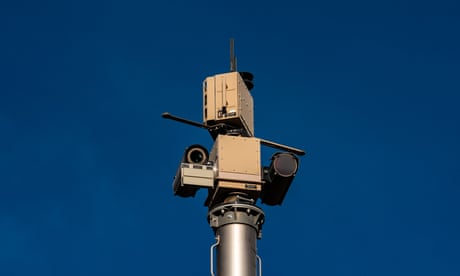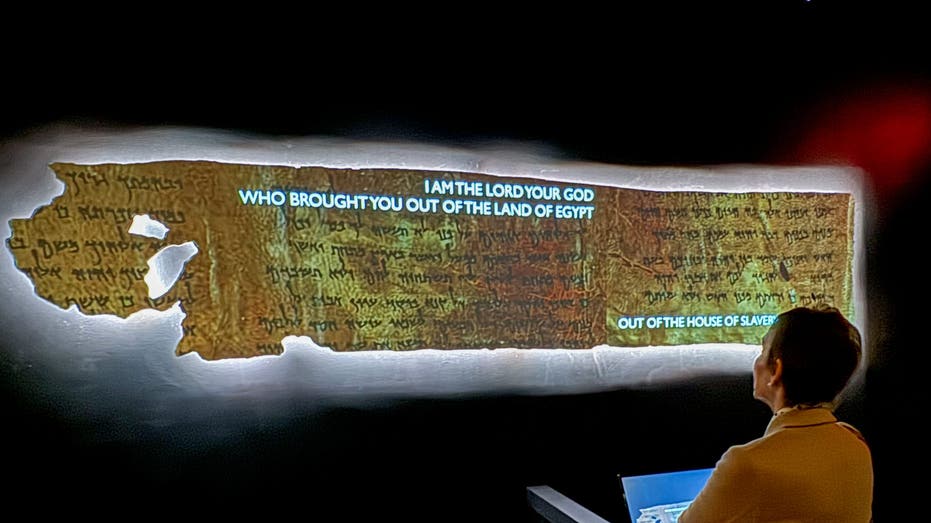- by foxnews
- 07 Apr 2025
‘Never sleeps, never even blinks’: the hi-tech Anduril towers spreading along the US border
‘Never sleeps, never even blinks’: the hi-tech Anduril towers spreading along the US border
- by theguardian
- 17 Sep 2022
- in news

On a hot May afternoon in southern California, near the border with Mexico, white-and-green border vehicles patrol the two-lane highway, black helicopters glide across the sky - and their latest companions, autonomous surveillance towers built by the tech defence company Anduril, peek over the ridges.
One Anduril tower, perched on a hill, has a clear view over the rusty brown border wall and into the Mexican town of Tecate. From here, it can detect people who climb over the wall and walk across the rugged landscape on the US side. Approach the hill and the camera atop the tower swivels toward you.
These boulder-speckled hills of the Otay Mountain Wilderness of California have seen a sharp increase in border crossings in the last year, according to US Customs and Border Protection (CBP). Since March 2020, the US has expelled nearly 2 million people under Title 42, a pandemic-era rule that closes safe ports of entry to asylum seekers. Rather than wait in Mexico border towns, where they are at risk of kidnapping and sexual assault, migrants have instead attempted to reach US soil via dangerous routes - across deserts, mountains, rivers and oceans. More than 50 died in June after they were abandoned in a truck in the sweltering Texas heat.
Now, as migrants cross the border, they are being watched full-time.
Powered by solar panels, the Anduril towers operate day and night and can be set up in remote areas, including near military bases, airports and oil and gas pipelines, the company boasts on its website. The towers use an artificial intelligence system called Lattice to autonomously identify, detect and track "objects of interest", such as humans or vehicles. The cameras pan 360 degrees and can detect a human from 2.8km away.
When the system identifies an object, it sends a notification to border agents on their phone or desktop, and an image appears with bright green rectangles around the item, according to an Anduril promotional video. CBP has described these towers as "a partner that never sleeps, never needs to take a coffee break, never even blinks".
The Anduril tower near Tecate is just one in a chain of hundreds of surveillance towers installed over the last two decades along the southern border. Not all are made by Anduril, but the company is making aggressive moves. According to a freedom of information request shared with the Guardian by Empower, CBP has a contract with Anduril to deploy a total of 189 autonomous surveillance towers on the south-west border.
All this new surveillance is driven by investment from big tech - specifically the billionaire PayPal co-founder and Trump supporter Peter Thiel, whose venture capital firm Founders Fund is a large investor in Anduril. The firm itself was set up in 2017 by Palmer Luckey, a former Facebook employee who identifies as a libertarian and has donated to a pro-Trump group. Luckey's goal, he says in his bio on the company site, is to "radically transform the defence capabilities of the United States and its allies by fusing artificial intelligence with the latest hardware advancements". Anduril, he told Wired, was named after a sword from The Lord of the Rings.
Initially, the company pitched its towers to a Department of Homeland Security (DHS) office in California, framing them as a cheap border security option. But in 2020, after a successful pilot project in the San Diego sector, the Trump administration approved a contract to deploy autonomous towers along the full length of the south-west border.
Boasting of the towers' effectiveness, Anduril's chief revenue officer, Matt Steckman, told the Big Bend Sentinel that data showed a spike in alerts in the weeks after they are installed, then a decrease as smugglers appear to learn their locations and avoid them. "You'll see traffic sort of squirting to the east and west," Steckman said. Anduril did not respond to requests for comment.
Border patrol agents are certainly big fans. In April, a tower alerted agents to 171 migrants crossing the border into Texas, where agents detained them and sent them to CBP stations for processing. Agents also regularly share photos of large groups they intercept using the towers. In April, Chief Patrol Agent Sean McGoffin tweeted a photo of about a dozen people standing in the Texas desert. "Agents working the midnight shift were able to spot the group with the assistance from surveillance tower technology," he wrote.
The Anduril towers fit into an expanding virtual wall, one that doesn't just trace the border but also extends 100 miles into the US interior and includes highway checkpoints, predator drones, licence plate readers, facial recognition, ground sensors, and mobile surveillance mounted on vehicles, not to mention the digital tracking of migrants in detention. CBP is even piloting robot dogs to help agents patrol the border.
This expansion of border security is largely bipartisan: Trump attracted a lot of attention for trying to expand the physical wall and approving new surveillance, including Anduril's towers, but the legacy of the last four administrations continues under Joe Biden. During the 2020 election campaign, Biden said building a physical wall had not deterred people from crossing and that "not another foot" of border wall would be built on his watch. Instead he has promised more DHS funding for "smart security" along the border. (In July, his administration did authorize new wall construction in Arizona, to close gaps in a border wall first approved by Trump.)
Biden's promise of more surveillance is being made good: CBP took $21m from Congress in the 2022 omnibus bill for autonomous surveillance towers, and its budget request for 2023 includes another $13.5m, which would be used to consolidate and support more than 700 surveillance towers, built by different companies, with varying degrees of functionality, along the northern and southern borders.
CBP confirmed the plan to integrate the towers to the Guardian. In its draft budget request, it said that although the surveillance towers provide "significant situational awareness", they rely too much on humans to detect people crossing the border. The goal now is to "seamlessly" combine the various operating systems of the different towers, to "easily control the towers and exploit useful data" as part of a long-term goal to use more automation to stop "threats". The agency did not answer a list of questions regarding border surveillance.
Sheriffs in border communities argue that new technologies, like rescue beacons and the Anduril towers, are helping to save lives. "We have rescued quite a few people in distress because of new tools," the Culberson county sheriff, Oscar Carrillo, told the Dallas Morning News.
But in August, members of Congress representing immigrant and border communities sent a letter to the House speaker Nancy Pelosi, Senate majority leader, Chuck Schumer, and House majority leader, Steny Hoyer, in which they expressed their concern over the harm the new border surveillance money would cause migrants, border residents, Indigenous communities, journalists and protesters. "We have strong reservations about funding more invasive technologies that are wasteful and insidious," they wrote.
Pedro Rios, director of the US-Mexico border program for the American Friends Service Committee, a US-based social justice organisation, goes further. He calls the expansion of the digital wall "deadly" because it pushes people to take longer routes to evade detection, contributing to thousands of deaths at the southern border.
Rios lives in Chula Vista, a short drive from the border wall that slices across the sandy beach and into the Pacific Ocean, dividing Imperial Beach from Tijuana. Here, too, the ubiquitous border patrol agents drive their ATVs along muddy roads, helicopters hover above, and surveillance towers watch from higher ground.
Rios indicated a recently installed surveillance tower that was aiming its infrared camera at the crashing waves. He said smugglers carry migrants on jet skis and other marine vessels. "There's been an increase in people that are crossing through smaller panga boats," he said.
It has become significantly harder to cross the border without detection in the last decade, according to CBP data published by the American Immigration Council, and last year Maria Eugenia Chavez Segovia from Mexico City drowned along with two other people when a smuggler boat ran aground off Point Loma. Agents had already twice intercepted her on land and returned her to Mexico.
Rios argues the bipartisan project of hardening the border is killing people. He has spotted makeshift ladders hanging from the wall, and since 2019, when the DHS increased the height of the wall in southern San Diego from 17ft to 30ft, the number of severe injuries and deaths has increased. (In another reversal of Biden's campaign promise, his administration announced in June that it would increase the height of the wall in other sections, too.)
As well as being deadly, increased surveillance infringes on the civil liberties of people living near the border, Rios believes, because they are often not consulted before new tech is deployed. He grew up in south San Diego, and identifies as a "fronterizo", or borderlander, and has family on both sides of the frontier, but notes that CBP did not consult nearby residents before installing the infrared tower overlooking the beach. (CBP did not respond when asked to confirm.)
As a child, he said, he watched the borderlands from a swing in his back yard. Some of his classmates went on to become border patrol agents. Over the years, he says, he has witnessed a hardening of the border.
"All of this area, where I grew up and call home, has undergone a process of militarization that continues to expand," he said. "The use of surveillance technologies is an extension of that militarization."
This militarization began in the 1990s under Bill Clinton, whose policy of "prevention through deterrence" aimed to make some areas of the border more like a fortress, in order to drive migration into harsher regions like the Arizona desert.
Then, in 2005, George Bush established a multibillion-dollar program called the Secure Border Initiative Network (SBINet). It was an attempt to deploy a virtual fence along the border - including ground sensors to detect footsteps and vehicles, and radar and cameras mounted on towers - to gather data about "objects of interest" and send it to command centres, so border agents could better respond to migrant crossings. After a 2010 report by the Government Accountability Office found SBINet was over budget and didn't deliver on its goals, Barack Obama cancelled it the following year - though the infrastructure remained.
Instead, first Obama and then Trump funded a different program that they hoped would be an improvement: Integrated Fixed Towers, which consist of multiple cameras, radar, spotlights, laser illuminators and communications equipment mounted 180ft above the ground "to provide long-range, persistent surveillance" according to a CBP report. Built by defence tech company Elbit, the towers send data to a system called Torch, which it developed for the Israeli military. CBP has also deployed Mobile Video Surveillance Systems (MVSS), extendable towers with long-range infrared cameras that sit in the beds of trucks and are operated by border patrol agents.
All along, officials have claimed the new technology would deter migration and help migrant safety, yet nearly 10,000 migrants have died crossing the border in the last 25 years, and the deaths are increasing, according to CBP numbers obtained by the Washington Examiner. Sam Chambers, a geographer at the University of Arizona who studied SBINet, has found that people take longer, more strenuous paths to avoid surveillance towers. Between 2002 and 2016, he found the death rate increased by a factor of five.
But the new tech is big business. The border security market, globally, is now worth $45bn, according to a recent report by the market research company IMARC Group, as countries, not least the US, invest more in unmanned border security in response to global conflict, climate breakdown and displacement.
In the US, tech companies lobby heavily for these government contracts. Anduril, for example, has spent $520,000 so far this year and $930,000 last year on lobbying the US Senate, the House of Representatives and the DHS on budget decisions.
"Migrants don't have paid lobbyists in DC, but these military tech corporations do," said Julie Mao, co-founder and deputy director of Just Futures Law, an immigration law project. "That is why the 'smart wall' messaging and border surveillance money is growing at such a high rate."
The potential contracts are huge. According to analysis by Just Futures Law shared with the Guardian, CBP's budget for 2023 includes about $1bn in border surveillance money, including for helicopters, border patrol vehicles and a mobile map-based application called a Team Awareness Kit (TAK) that helps agents see data gathered from towers and other sources in real time. Just Futures Law found that about 5,000 TAK units have been deployed to border patrol agents, primarily along the south-west border, and CBP plans to hand out nearly 20,000 kits total. Mao called it "deeply disappointing" that the Biden administration is investing in the "smart border wall".
Anduril, meanwhile, is moving to expand: it is attempting to raise $1.2bn to increase its valuation, TechCrunch reported.
To Rios, the framing of migration by media and politicians in war-like terms - such as "surge" or "invasion" - drives more investment in border security.
"Once these private companies are able to respond to it with their fancy enforcement toys, that they can then market and sell to the government, that's when we have the deployment of the towers and sensors and other gadgets," he said.
"As a way to cleanse their politics around border issues, the Democrats have pushed for the idea of a virtual or surveillance border wall, or smart technologies - that really aren't that smart at all, because we see the impact to human life continues to be human suffering, injuries and death."
- by foxnews
- descember 09, 2016
Ancient Ten Commandments fragment of 2,000-year-old manuscript to go on display at Reagan Library
The "Dead Sea Scrolls" exhibit, announced at the Ronald Reagan Presidential Library and Museum, features ancient Jewish manuscripts, plus the rarely seen Ten Commandments Scroll.
read more


